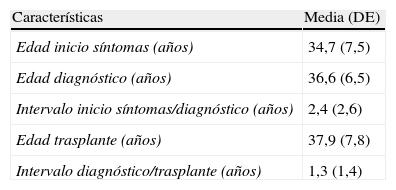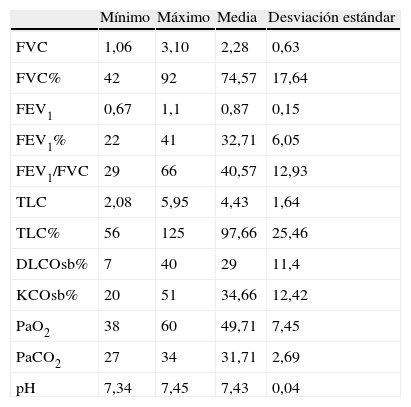La sporadic lymphangioleiomyomatosis (S-LAM, «linfangioleiomiomatosis esporádica») es una enfermedad rara que afecta a la mujer. Se caracteriza por una proliferación anormal de células musculares lisas inmaduras, células LAM, que crecen de una manera aberrante en el pulmón. La enfermedad no tiene tratamiento, evolucionando hacia la insuficiencia respiratoria. El trasplante pulmonar (TP) puede ser una opción terapéutica en este estadio. Nuestro objetivo es el estudio de 7 pacientes sometidas a TP por S-LAM.
Material y métodoSe estudiaron las características clinicodemográficas, de diagnóstico, y los resultados. Se realizó un análisis descriptivo y se estimó la supervivencia mediante el método de Kaplan-Meier.
ResultadosLa edad media de aparición de los síntomas, diagnóstico y TP fue de 35, 37 y 38 años, respectivamente. El síntoma más frecuente fue la disnea. La media del volumen espiratorio forzado en el primer segundo fue del 32,7%, y la de difusión del monóxido de carbono, del 29%. La supervivencia fue del 100, 85,7 y 57,1% a uno, 3 y 5 años, respectivamente. Tres pacientes fallecieron por bronquiolitis obliterante y en 2 necropsias realizadas no se observó recidiva de la enfermedad.
ConclusionesEl TP es una opción terapéutica en pacientes con S-LAM en insuficiencia respiratoria avanzada.
Sporadic lymphangioleiomyomatosis (S-LAM) is a rare disease that affects only women. It is characterized by an abnormal proliferation of immature smooth muscle cells (LAM cells) that grow in an aberrant manner in the airway, parenchymal lung lymph and blood vessels, determining the onset of pulmonary cystic lesions. The disease has no treatment, progressing to respiratory failure, and lung transplantation (LT) may be a treatment option at this stage. Our goal was to study 7 patients undergoing LT for S-LAM.
Material and methodWe studied a series of clinical and demographic characteristics, diagnostic modality and post-transplant outcomes. We performed a descriptive analysis of the series. The Kaplan-Meier method was used to estimate survival.
ResultsThe mean age of onset of symptoms was 35 years, the diagnosis of 37 years and that of LT 38 years. The most common symptom was dyspnea. Four patients had a history of pneumothorax and pleural effusion. The mean forced expiratory volume in one second was 32.7% and the diffusing capacity for carbon monoxide was 29%. All patients were subjected to LT and survival was 100, 85.7 and 57.1% at one, 3 and 5 years, respectively. Three died of bronchiolitis obliterans and 2 necropsies did not show evidence of disease recurrence.
ConclusionsLT is a therapeutic option in patients with S-LAM with an advanced respiratory functional impairment.
Artículo
Comprando el artículo el PDF del mismo podrá ser descargado
Precio 19,34 €
Comprar ahora








